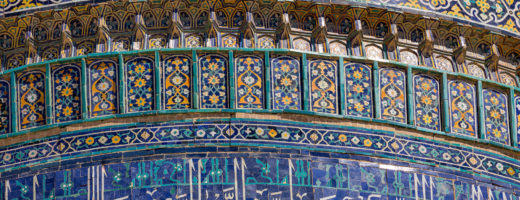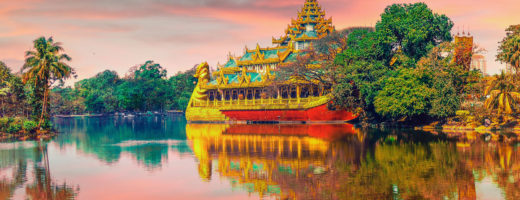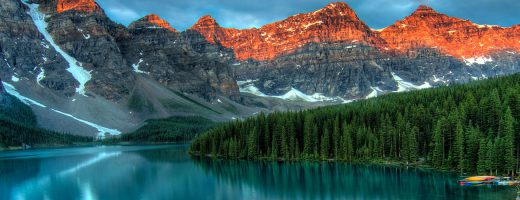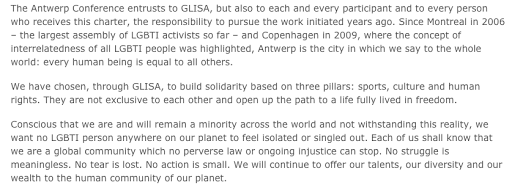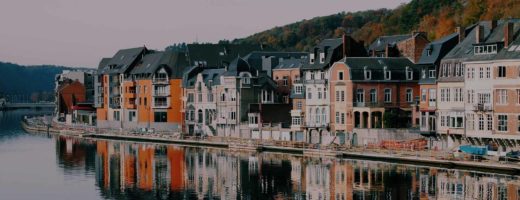Central Asia’s holiest city, Bukhara has buildings spanning a thousand years of history, and a thoroughly lived-in old centre that probably hasn’t changed much in two centuries. It is one of the best places in Central Asia for a glimpse of pre-Russian Turkestan. It was as capital of the Samanid state in the 9th and
Uzbekistan: Samarkand Photo Gallery 2
The ancient city of Samarkand is a crossroad of diverse world’s cultures. Founded in the 7th century B.C. as ancient Afrasiab, Samarkand reached a cultural and commercial peak in the Timurid period from the 14th to the 15th centuries. The significant existing monuments include the Registan Mosque and madrasas, Bibi-Khanum Mosque, the Shakhi-Zinda compound and
Uzbekistan: Samarkand Photo Gallery 1
Samarkand is the second-largest city in Uzbekistan and the capital of Samarkand Province. The city is most noted for its central position on the Silk Road between China and the West, and for being an Islamic center for scholarly study. (See other photo galleries: http://www.globalgayz.com/asia/uzbekistan/)
Uzbekistan: Fergana Valley, Rishtan Town Photo Gallery
Fergana Valley is full of ancient and modern history as part of the Silk Road and the scene of a government massacre of protestors in 2007. Today it is quiet and many merchants and craftspeople ply their trades. Two well-known artisans are the Rustam Usmanov pottery makers of unique blue glaze “ishkor” which comes from
Uzbekistan: Fergana Valley, Kokand City Photo Gallery
Kokand is a city in Fergana Province in eastern Uzbekistan with a population of about 200,000.It is on the crossroads of ancient trade routes and has existed since at least the 10th century. It was frequently mentioned in traveler’s accounts of the caravan routes between India and China.The present city began as a fort in 1732.
Uzbekistan: Fergana Valley & City + Andijan City Photo Gallery
Andijan is the Fergana Valley’s largest city and its spiritual mecca. It is probably the country’s purest Uzbek city, and the best place to observe Uzbeks in their element. Andijan is one of the oldest cities in the Fergana Valley. In some parts of the city archeologists have found items dating back to the 7th
Uzbekistan: Drive From Tashkent to Andijan City Photo Gallery
Uzbekistan: The eastward drive from the capital of Tashkent to the city of Andijan, near the Chinese border, passes along a rugged highway that is smooth in places and torn up in others. It is heavily trafficked with tanker trucks carrying oil and natural gas. There are police checks that slow down traffic and police
Uzbekistan: Tashkent Photo Gallery 2
Tashkent (meaning ‘Stone City’) is the capital of Uzbekistan with a population of about 2,309,300. Due to its position in Central Asia, Tashkent received Persian, Chinese and Turkic influences in its early history, before Islamisation in the 8th century AD. After destruction by Genghis Khan in 1219, the city was rebuilt and profited from the
Uzbekistan: Tashkent Photo Gallery 1
Tashkent is the capital of Uzbekistan with modern and ancient buildings and lifestyles. From donkey carts to Mercedes-Benz (a few) the city is a complex mix of ugly Soviet-style apartment blocks, sleek modern office buildings and historic Islamic-style mosques and museums. There is a wide range of fine hotels from plain two-star digs to five-star
Tibet Random Rural Photos
Tibet is a dramatic country with vast grassy plains and rugged high mountains. It is a Buddhist country with countless monasteries, temples, shrines and symbolic stupas. The lifestyle is rural with most Tibetans engaged in agriculture and animal raising. Mount Everest is called Chomolungma by Tibetans which means ‘Goddess mother of the Earth’. It’s easy
Tibet: Lhasa – Sera Monastery
Sera Monastery is one of the ‘great three’ Gelukpa university monasteries of Tibet. It is about 5 kms north of Lhasa in the hills. The monastery oversees 19 smaller hermitages (including Pobanka Monastery) and nunneries all located in the foot hills north of Lhasa. The Sera Monastery campus is a complex of structures with the
Tibet: Lhasa – Pabonka Monastery
Pabonka Monastery is a historical hermitage (founded in the 7th century) about 8 kilometers northwest of Lhasa on the slopes of Mount Parasol. It is well known today partly because it’s the site where ‘sky burials’ take place. Sky burials involve the dismemberment of deceased human corpses and leaving the remains open to the sky
Tibet: Lhasa – Jokhang Temple
Jokhang Temple is located on Barkhor Square in central Lhasa. For most Tibetans it is the most sacred and important temple in Tibet. It is in some regards pan-sectarian, but is controlled by the Gelug Buddhist school. The temple’s architectural style is a mixture of Indian vihara design, Chinese Tang Dynasty design, and Nepalese design.
Tibet: Lhasa – Summer Palace
The Summer Palace is the former summer home of HH Dalai Lama. It’s now a museum, as designated by the communist Chinese, but many native Buddhists still consider it a sacred place and offer prayers at the temples within. Foreign visitors cannot go in to any temples or museums or to other cities or sites
Tibet: Lhasa – City Photos
Visiting Lhasa city is like finding a ghost in a closet full of living beings. It is at once an ancient seat of tradition that lives in the shadow of progressive communist changes. Throughout the city and beyond there is indelible Tibetan ethos mixed with the artifice of Chinese manufacture. The imperialist occupier would like
Tibet: Lhasa – Potala Palace
The Potala Palace is the former home and seat of government for the Buddhist leader Dalai Lama. He was chased out of Tibet when the Chinese invaded Tibet in 1959 and took over the country. Since then the Potala Palace has not been used for government or religious functions. The Chinese have designated it as
Tibet Faces
The faces of Tibet are diverse in appearance and in lifestyle. From hip city teens to rugged farmers to aged monks and wandering tourists, the variety is panoramic. There is wonder, humor, puzzlement and more than a little hidden resentment at living under an occupying and repressive communist system over which they have no control.
Mount Everest Photo Gallery
Mountains are generally measured from sea level, in which case Mount Everest (29,028 feet; 8,848 meters) is the highest. Hawaii’s Mauna Kea, though, rises an astonishing 33,476 feet (10,203 meters) from the depths of the Pacific Ocean floor. Measuring from base to peak, Mauna Kea is the tallest mountain on earth, of which only about
Antwerp, Belgium World OutGames Human Rights Conference
August 4-7, 2013 Preceding the OutGames is an international Human Rights Conference that brings together hundreds of LGBT activists and human rights leaders to present papers, hold seminars and give speeches. At the end of the conference a declaration of rights is composed and published.
Antwerp, Belgium World OutGames Opening Ceremony
August 2, 2013 The OutGames opening ceremony was modest compared to previous years. It was held outdoors in an open area next to the harbor. It was rather crowded as thousands of athletes from 25 countries assembled to hear the speeches and music.
Antwerp, Belgium World OutGames Swimming Competition
The swimming competition took place over the course of a week. There were several dozen categories of races according to the stroke style (butterfly stroke, freestyle stroke, back stroke and breast stroke) and separated into male/female races. The result was a couple of hundred races that ranged from 50 meters long (one length of the
Belgium, Brussels City Walkabout
Brussels is the capital and largest city of Belgium and the capital of the European Union (EU). The city has a population of 1.2 million and a metropolitan area with a population of over 1.8 million. Over the millennium it has a tumultuous history of invasion, revolts and conquests. In World War I Brussels was
Belgium, Antwerp City Walkabout
Antwerp is a city and municipality in Belgium with a population of about 510,600. The Antwerp metropolitan area is currently the second largest in Belgium. The city is located on the river Scheldt, which is linked to the North Sea by the Westerschelde estuary. The Port of Antwerp is one of the biggest ports in
Belgium, Brugge City
Bruges (Dutch: Brugge) is the capital and largest city of the province of West Flanders in the Flemish Region of Belgium in the northwest of the country. The city’s total population is 117,073 of which around 20,000 live in the city centre. The metropolitan area has a total of 255,844 inhabitants. Because of it numerous
Belgium, Ypres City
The Ypres municipality comprises the city of Ypres and ten small villages, home to some 34,900 inhabitants. During World War I, Ypres was the centre of intense and sustained battles between German and Allied forces. Ypres is an ancient town, known to have been raided by the Romans in the first century BC. During the Middle

